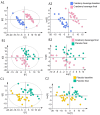Polyphenol-Rich Cranberry Beverage Positively Affected Skin Health, Skin Lipids, Skin Microbiome, Inflammation, and Oxidative Stress in Women in a Randomized Controlled Trial
- PMID: 39339726
- PMCID: PMC11434900
- DOI: 10.3390/nu16183126
Polyphenol-Rich Cranberry Beverage Positively Affected Skin Health, Skin Lipids, Skin Microbiome, Inflammation, and Oxidative Stress in Women in a Randomized Controlled Trial
Abstract
This study aimed to determine whether a polyphenol-rich cranberry beverage affects skin properties, lipids, and the microbiome in women using a randomized, double-blinded, placebo-controlled, cross-over design. Twenty-two women with Fitzpatrick skin types 2-3 were randomized to drink a cranberry beverage or placebo for six weeks. After a 21-day washout, they consumed the opposite beverage for six weeks. Six weeks of cranberry beverage significantly reduced UVB-induced erythema, improved net elasticity on the face and forearm, smoothness on the face, and gross elasticity on the forearm compared to the placebo. When stratified by age, these effects of the cranberry beverage were primarily observed in women >40 years old. SOD activities were improved after six weeks of cranberry beverage consumption compared to the placebo, while glutathione peroxide and TNF-α were improved compared to baseline. These effects were found to differ by age group. Skin lipid composition was modulated by both the cranberry beverage and the placebo. Cranberry beverages did not change α- or β-diversity but altered the abundance of several skin microbes at the species and strain level. Consumption of a cranberry beverage for six weeks improved specific skin properties and oxidative stress and modulated skin lipids and microbiome compared to placebo.
Keywords: cranberry; oxidative stress; photoaging; skin aging; skin lipids; skin microbiome.
Conflict of interest statement
Authors E.J. and C.K. were employed by Ocean Spray Cranberries Inc. L.C. completed all research contained in this paper as a doctoral student at the University of Florida and was hired by Ocean Spray Cranberries Inc. after her graduation while revising this manuscript. The remaining authors declare that the research was conducted in the absence of any commercial or financial relationships that could be construed as a potential conflict of interest.
Figures








Similar articles
-
Consumption of cranberry beverage improved endogenous antioxidant status and protected against bacteria adhesion in healthy humans: a randomized controlled trial.Nutr Res. 2014 May;34(5):420-7. doi: 10.1016/j.nutres.2014.03.006. Epub 2014 Apr 5. Nutr Res. 2014. PMID: 24916555 Clinical Trial.
-
Chronic consumption of a low calorie, high polyphenol cranberry beverage attenuates inflammation and improves glucoregulation and HDL cholesterol in healthy overweight humans: a randomized controlled trial.Eur J Nutr. 2019 Apr;58(3):1223-1235. doi: 10.1007/s00394-018-1643-z. Epub 2018 Feb 23. Eur J Nutr. 2019. PMID: 29476238 Free PMC article. Clinical Trial.
-
Effects of cranberry beverages on oxidative stress and gut microbiota in subjects with Helicobacter pylori infection: a randomized, double-blind, placebo-controlled trial.Food Funct. 2021 Aug 2;12(15):6878-6888. doi: 10.1039/d1fo00467k. Food Funct. 2021. PMID: 34126630 Clinical Trial.
-
Impact of Cranberries on Gut Microbiota and Cardiometabolic Health: Proceedings of the Cranberry Health Research Conference 2015.Adv Nutr. 2016 Jul 15;7(4):759S-70S. doi: 10.3945/an.116.012583. Print 2016 Jul. Adv Nutr. 2016. PMID: 27422512 Free PMC article. Review.
-
Consumption of cranberry as adjuvant therapy for urinary tract infections in susceptible populations: A systematic review and meta-analysis with trial sequential analysis.PLoS One. 2021 Sep 2;16(9):e0256992. doi: 10.1371/journal.pone.0256992. eCollection 2021. PLoS One. 2021. PMID: 34473789 Free PMC article.
Cited by
-
Natural protection against oxidative stress in human skin melanocytes.Commun Biol. 2025 Aug 26;8(1):1283. doi: 10.1038/s42003-025-08725-1. Commun Biol. 2025. PMID: 40858814 Free PMC article. Review.
-
The Role of Oxidative Stress in Skin Disorders Associated with Alcohol Dependency and Antioxidant Therapies.Molecules. 2025 Jul 25;30(15):3111. doi: 10.3390/molecules30153111. Molecules. 2025. PMID: 40807286 Free PMC article. Review.
References
-
- Zheng Y., Hunt R.L., Villaruz A.E., Fisher E.L., Liu R., Liu Q., Cheung G.Y.C., Li M., Otto M. Commensal Staphylococcus epidermidis contributes to skin barrier homeostasis by generating protective ceramides. Cell Host Microbe. 2022;30:301–313.e9. doi: 10.1016/j.chom.2022.01.004. - DOI - PMC - PubMed
Publication types
MeSH terms
Substances
Grants and funding
LinkOut - more resources
Full Text Sources
Molecular Biology Databases

